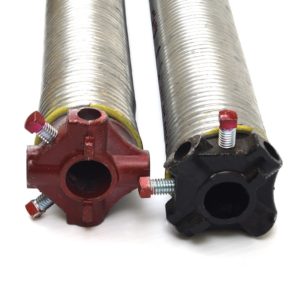Ottawa Garage Door > Blog > Garage Door Springs
Garage Door Springs: Torsion vs Extension Springs
All garage door springs essentially fall into two basic categories: torsion springs and extension springs. Knowing what you have is useful when you eventually need to replace the spring. Garage door springs are probably the most important component of the garage door, and you should ideally refrain from embarking on a DIY project to replace the same.
Extension springs

These springs essentially store energy by stretching or extending. They are normally located above the upper tracks on both sides of a door. When you open the door, the springs will extend in order to provide a counterbalancing force to open the door smoothly. The greater the force, the greater the extension. All extension springs are generally paired with safety cables to prevent the spring from becoming an unexpected weapon in the event of a failure. Most states legally require homeowners to install safety cables.
Torsion springs

Torsion springs typically utilize torque to open garage doors. These springs sit in the header of the garage door. They are normally placed directly above a door opening, usually on the metallic shaft. They are relatively coil-like in terms of behavior, and a torsion spring will gradually twist and coil on the shaft during the application of force.
Torsion springs rely on equitably distributing force across the metallic shaft to achieve a proper balance. Most residential garage doors with torsion springs have around 1-4 springs, and the number is usually dependent on the size, tensile strength, and the weight of the door.
What should you choose?
There are numerous types of sub-classifications. The most popular types of extension springs include open looped, double looped, and clip ends springs. The most common types of torsion springs include standard, early set, torque master, and steel rolling door extension springs. Ideally, you need a hire a certified technician to install the spring for you. You should select the spring based on the recommendations of the technician.
What are the differences between the two main types of springs?
Extension springs are generally far cheaper than torsion springs and this is why they are more commonly used in residential settings. Extension springs are generally more dangerous, especially if you do not have the necessary safety cables.
Torsion springs, on average, support a greater amount of weight and generally have greater longevity. They offer a superior level of balance and comfort, and with a torsion spring, opening and closing your garage door is far easier. They are far safer than extension springs, and on most counts, a torsion spring is almost always the better choice. When you are purchasing a new garage door, investing in a torsion spring is typically a smart choice that has long-lasting benefits.

